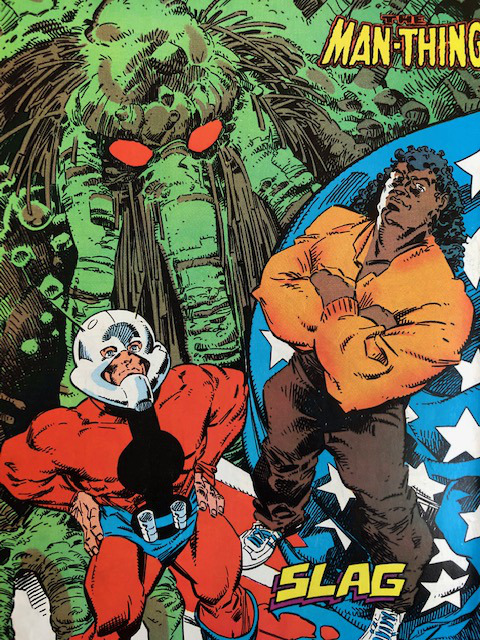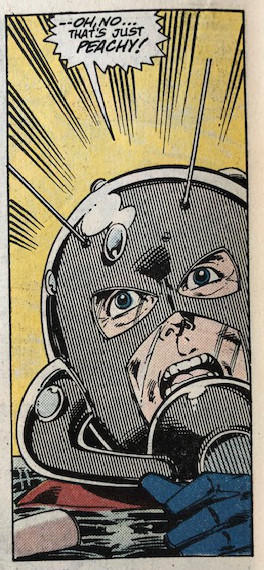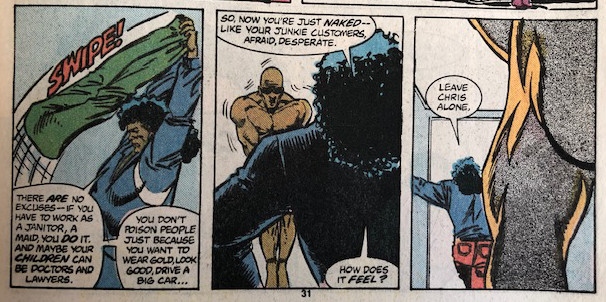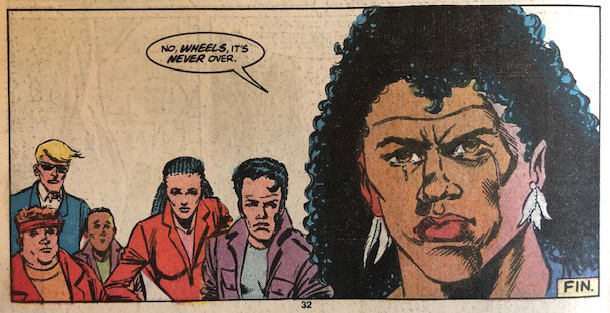

Marvel Comics Presents ran for 175 issues from 1988 until 1995. Each issue included four eight-page stories with typically two or three on-going features (and no ads). It spotlighted some of the leading creators of mainstream comics over a period of precipitous economic growth and even more rapid decline. Reading through it is an opportunity to revisit any number of weird aspects of 90s superhero comics. This blog is a primitive, oddly regimented, manifestly scattershot crawl through an often disappointing but occasionally splendid comic. All image copyrights are Marvel's. Issue credits linked below. Updated on Wednesdays.
Marvel Comics Presents #11: Late January 1989(12.04.19)
Credits: grandcomicsdatabase

We're now out of Wolverine territory, though he's destined to return many times over in MCP. Here, Leonardi cooks up an oddly plaintive Colossus, seen from above holding a tattered American flag. Thematically, this squares nicely with the "God's Country" feature, but Austin's inks obscure the bouncy textures that Craig Russell expertly preserves in the feature itself. On the back cover, Leonardi's Ant-Man and Slag are gifted with eerily interchangeable physiques while Man-Thing receives one of his strangest treaments yet, appearing something like an Ent with male pattern baldness. A strange but vaguely charming outing.

A. Colossus, "God's Country" [2/8]
Nocenti swiftly (though not all that convincingly) brings together the three main threads of the feature: Colossus, a typical American family, and Contra-thug mutants led by a shadowy Mr. Burnsesque power broker. The heavy behind the "Cold Warriors," Alexander, is introduced with some nice layout touches--in particular, some compelling, open, white panels. Throughout and especially in these light touch moments, Russell's inks really shine. As with Choate in "Elements of Terror," Nocenti's Alexander offers a villainous monologue that capably riffs on mangled American political ideals. Some of the action here--most notably, an execution of a "renegade" Cold Warrior--proves a bit cramped and Leonardi's Colossus slides into flat-out rubbery textures. Even so, there's some urgency and poignancy with the boy in the family, Zachery. trying to fight off his attackers with a squirt gun. A clear uptick from the first installment.

B. Man-Thing, "Elements of Terror" [11/12]
For the first time, Sutton's limited contribution to this piece is acutely felt. Man-Thing is reconstituted from the swamp and swiftly reinserts himself into the story, but the pencils have fallen off rather badly with Don Hudson stepping in, but flattening out what should have been a resonant payoff of Marea's arc. (The exceptionally faint line art here is bad enough in spots that printing issues wouldn't surprise me.) The "super-soldier-monster" character design remains a lovely touch. It's also played for something close to laughs as we see a platoon of these grotesque creatures sitting attentively through a briefing in an airplane cabin. We're also treated to the payoff of an earlier mystery regarding the identity of "codename: grape." (Gorbachev, as it turns out.) Gerber--perhaps more than any contributor to MCP--has squared up to the challenge of pushing the limits of dense eight-page storytelling, bouncing from the Rockies to Washington to the Swamp in just four panels. And, even while there are some headspinning moments, the narrative density feels principled and rewarding.
C. Ant Man, "Drain Storm"

A shaggy dog story from Len Wein and Bob Layton with Ant-Man chasing a lost ring down a drain and grappling with precisely the tepid perils one would expect--rats, ants, plumbing, grates, and so on. Given these lowest of conceivable stakes, this feature only seems evaluable as a formal exercise for playing with the recontextualized familiar objects and trying to cook up even a modicum of tension. Unfortunately, Wein can't muster anything unexpected or, indeed, anything all that playful. Layton, who handles pencils and inks, works cleanly here, but the only standouts of the feature are the liquid textures of the flowing drawin and the laudable commitment to using a variety of screentones to capture Ant-Man's helmet. This is the best example of a "replacement level feature" we've seen yet. A C+ feature made flesh.

D. Slag (of Wolfpack), "Over and Over!"
*long sigh* Slag surpasses El Aguila for "most obscure featured character" and this one-hitter marks a conspicuous thematic first for MCP: disastrous attempts in "edgy and socially relevant" storytelling. The missteps of this kind of story are by now pretty damn familiar: black characters get exceptionally short shrift in mainstream superhero comics, but are wildly overrepresented in stories about drugs. Here, Slag the lone black character from the Wolfpack--an "urban" teenage team that just limped through a twelve issue series--is interrupted mid-basketball game by his cousin, who's being threatened by Ty-Rock, a local crack dealer. A cringe-inducing confrontation quickly follows.
Ron Wilson's pencils are par for late 80s, but nothing can overcome the idiocy and ill-considered slapstick of the script, which plays out with Slag stripping Ty-Rock naked. There might be some sort of implicit reflection on hope and fatalism baked into the final panels where Slag's cousin ambles back to score more drugs, but the rest of the feature is so rife with tone deaf silliness that it's a mystery what John Figueroa might have hoped for here. For all its searing hot stereotypes, the 80s nostalgia is undeniable, colllding D.A.R.E. with "Lois Lane" Black for a Day" vapidity. I'm also afraid to say that this won't be the most offensive "socially relevant" story we'll seen in MCP. Not by a longshot.
Power Ranking: Man-Thing (B+), Colossus (B), Ant-Man (C+), Slag (F)